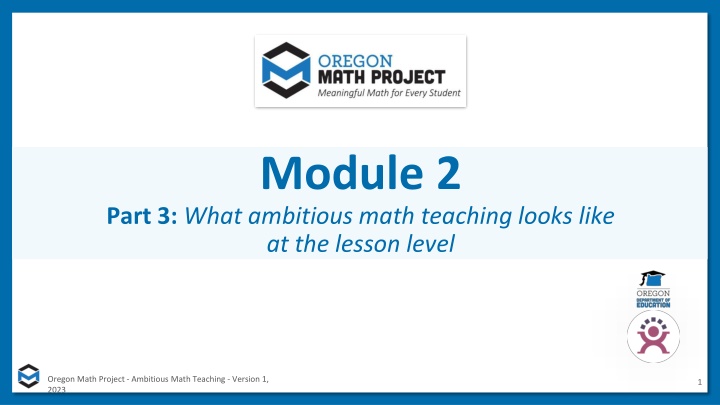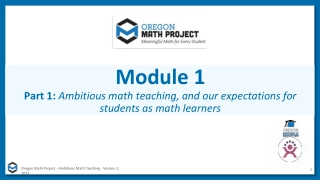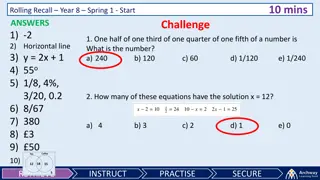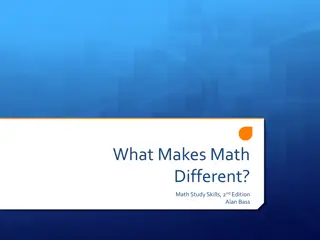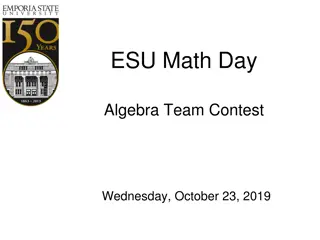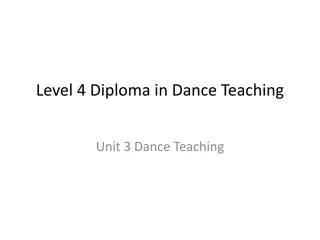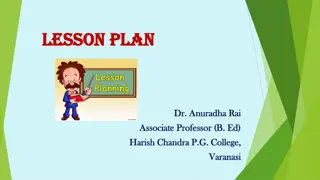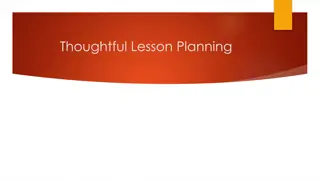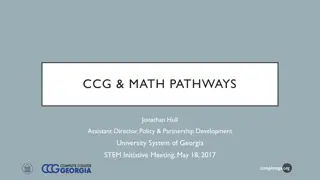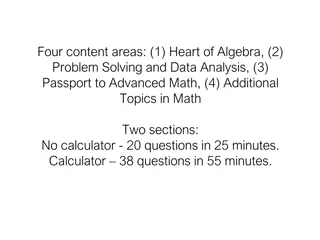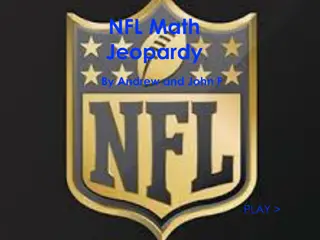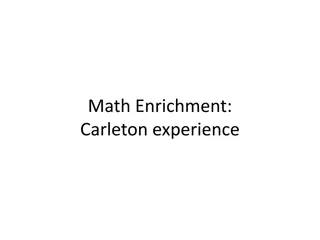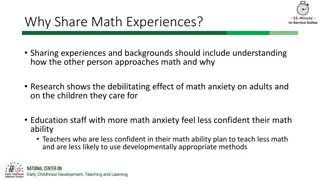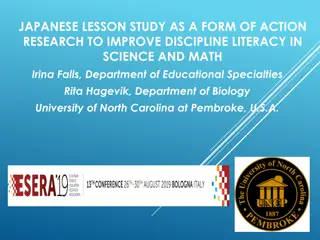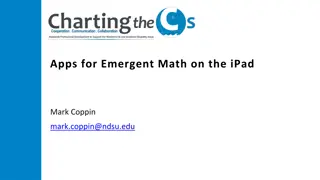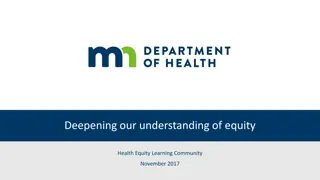Deepening Understanding of Lesson Planning for Ambitious Math Teaching
In this session of the Oregon Math Project - Ambitious Math Teaching, the focus is on planning rich lessons that engage students' rough draft thinking and maintain cognitive demand. The agenda includes setting norms, connecting to research resources, and using a Lesson Planning Framework. Participants revisit and revise norms to create a supportive learning environment where students feel empowered to share their thoughts openly. The session aims to enhance educators' abilities to craft lessons that promote deep mathematical understanding.
Download Presentation

Please find below an Image/Link to download the presentation.
The content on the website is provided AS IS for your information and personal use only. It may not be sold, licensed, or shared on other websites without obtaining consent from the author.If you encounter any issues during the download, it is possible that the publisher has removed the file from their server.
You are allowed to download the files provided on this website for personal or commercial use, subject to the condition that they are used lawfully. All files are the property of their respective owners.
The content on the website is provided AS IS for your information and personal use only. It may not be sold, licensed, or shared on other websites without obtaining consent from the author.
E N D
Presentation Transcript
Module 2 Part 3: What ambitious math teaching looks like at the lesson level Oregon Math Project - Ambitious Math Teaching - Version 1, 2023 1
Essential Questions of the Modules What is ambitious math teaching? Why is a 2 + 1 model important for equitable outcomes in mathematics? Module 1: Foundations of High School Math Instruction What does ambitious math teaching look like at the unit, lesson, and task levels? How do we value and build on the mathematical strengths of students who are often excluded by schooling? Module 2: Principles and Practices of Ambitious Math Teaching What planning, teaching, and assessment practices can be used to sustain ambitious math teaching? Module 3: Principles and Practices of Sustainability Oregon Math Project - Ambitious Math Teaching - Version 1, 2023 5
Reconnecting to our thinking from the previous sessions 6 Oregon Math Project - Ambitious Math Teaching - Version 1, 2023
Session 12 The focus of this session is to deepen our understanding of how to plan rich lessons that elicit students rough draft thinking and maintain the cognitive demand for students. Ambitious math instruction at the lesson level: Planning a rich lesson Agenda for this session: 1. Setting and maintaining norms: Reconnect with and revise our norms for interacting together Connecting to research: Resources for planning a lesson that maintains cognitive demand Connecting to research: Resources for planning a lesson that elicits students rough draft thinking Planning for action: Using the Lesson Planning Framework to plan a lesson that elicits students rough draft thinking and maintains the cognitive demand for students 2. 3. 4. M2 P3 Table of Contents 7 Oregon Math Project - Ambitious Math Teaching - Version 1, 2023
Setting and maintaining norms Reconnect with and revise our norms for interacting together Oregon Math Project - Ambitious Math Teaching - Version 1, 2023 8
Revisiting norms [Insert your group norms] Rights of a Learner You have the right to: Be confused Make mistakes Say what makes sense to you Share unfinished or rough draft thinking and not be judged (Kalinec-Craig, 2017) Oregon Math Project - Ambitious Math Teaching - Version 1, 2023 10
Connecting to research: Resources for planning a rich lesson that maintains cognitive demand Oregon Math Project - Ambitious Math Teaching - Version 1, 2023
Habit Activators: Instructional activities to engage students in reasoning & sensemaking Worked Examples: Using one or more pieces of student work/thinking with a reasoning prompt to engage students in analyzing the work. True/False Discussions: What false conjecture might be productive for your students to explore? Consider conjectures that are partially true and/or lack precision. How will you engage students in exploring and refining the conjecture? Why? Let s Justify (Kazemi & Hintz, 2014): Identify/create a task where students will be asked to create a justification. How will you engage students in comparing their ideas with others, reflecting on their own work and then using those reflections to refine/add on to their thinking? Connecting Representations (Kelemanik, Lucenta, & Creighton, 2016): Identify 3 pairs of representations (e.g. visual model with story context, symbolic expression with story context, etc). Decide which representation you will omit. Task is to have student match representations, using key structures they notice to justify their connections. Then to create the missing representation. Notice and Wonder (Fetter, 2011): Find a place in the lesson/activity where students would benefit from recording some noticing and wonderings of a figure or worked problem - that they can use to access the task/activity and make/justify conjectures. And many, many others! Oregon Math Project - Ambitious Math Teaching - Version 1, 2023 13
Mathematical tasks as a framework for reflection Read the chapter. Then, focus on Figure 4 and consider: Which of the factors for maintaining high-level cognitive demand do you want to focus on in your own practice? Why? Which factors that might cause the decline of high-level cognitive demand do you want to be aware of as you plan and implement tasks? Why? (Stein & Smith, 1998) Oregon Math Project - Ambitious Math Teaching - Version 1, 2023 14
Small Group Activity Directions: Use the workspace slide to reflect on the chapter. Oregon Math Project - Ambitious Math Teaching - Version 1, 2023 15
Preview of Workspace Slide Team names: Focus especially on Figure 4. Which of the factors for maintaining high-level cognitive demands do you want to focus on in your own practice? Why? Which factors that might cause the decline of high-level cognitive demands do you want to be aware of as you plan and implement tasks? Why? Oregon Math Project - Ambitious Math Teaching - Version 1, 2023 16
Debrief: Principles of ambitious mathematics teaching Which of these ideas are you thinking about in light of our work? What questions do you have? Ambitious teaching: Engages students in making sense of mathematical concepts Centers students thinking and reasoning through discourse Views students as capable of using their understandings and assets to solve authentic problems Values students thinking, including emergent understanding and errors Attends to student thinking in an equitable and responsive manner Ambitious teaching is teaching that deliberately aims for all students across ethnic, racial, class, and gender categories not only to acquire, but also to understand and use knowledge, and to use it to solve authentic problems. (Lampert & Graziani, 2009, p. 492) (Anthony et al., 2015) Oregon Math Project - Ambitious Math Teaching - Version 1, 2023 17
Connecting to research: Resources for planning a rich lesson that elicits students rough draft thinking Oregon Math Project - Ambitious Math Teaching - Version 1, 2023
Rough-Draft Talk in Mathematics Classrooms Read the article and be prepared to share. 1. How can we foster rough draft thinking? 2. Why is it important to foster rough draft thinking? 3. How can we: - develop non-evaluative sharing (rich discourse) - encourage public revisions - position students in-progress thinking as valuable Oregon Math Project - Ambitious Math Teaching - Version 1, 2023 20
Lets look at a Habit Activator that can support rough draft talk! v Oregon Math Project - Ambitious Math Teaching - Version 1, 2023 21
Metacognition and Rough Draft Thinking 1st Draft Thinking: I think (vertex, standard, or factored)................... form is important because it tells us that ,,,,, Why is it helpful to have all three forms of the equation? What I heard others say: I heard someone say This helped my thinking because . Revised Explanation: I used to think .. But now I think Because .. Study the graph and equations. Create a 1st draft answer to the question in yellow. Use the sentence stems if they are helpful. Oregon Math Project - Ambitious Math Teaching - Version 1, 2023 22
Metacognition and Rough Draft Thinking Why is it helpful to have all three forms of the equation? 1st Draft Thinking: I think that factored form is important because it helps us by listing out the x-intercepts by doing that we algebraically solve the dilation. This show us if it is concave up or down. Standard form shows us how we need to use all components of gravity to see it go up and down and using what we have in front of us. The vertex is given to us so we can find the x and y intercepts. What I heard others say: I heard someone say it is important because it helps us understand more aspects of the graph. If you think there is one equation there could be one that fits better because factored form gives x-intercepts standard gives y and the vertex gives the vertex. Revised Explanation: I used to think that gravity for it to go up and down was vertex now I learned it is actually dilation that shows concave up and down. Because I heard (Nuho) say factored gives us x intercepts, standard gives us y, and vertex gives the vertex of the graph. Now I think that all of them give and show dilation but standard form gives us the y-intercept which is the height of the parabola. Factored form is to help us find what the vertex is and we re given the x intercepts of the graph where we get to solve it algebraically. Lastly the vertex point is giving us the vertex and we have to find the x and y intercepts. Study the graph and equations. Create a 1st draft answer to the question in yellow. Use the sentence stems if they are helpful. Oregon Math Project - Ambitious Math Teaching - Version 1, 2023 23
Reflection on rough draft talk In reflecting on the reading and the Metacognition and Rough Draft Thinking Habit Activator, what do you want to remember about supporting students rough draft talk? How might you use the Metacognition and Rough Draft Thinking Habit Activator in your classroom? Why? How are you understanding the relationship between cognitive demand and rough draft talk? Why do you think it is especially important to support rough draft talk when working on cognitively demanding tasks? Oregon Math Project - Ambitious Math Teaching - Version 1, 2023 24
Small Group Activity Directions: Use the workspace slide to reflect on the habit activator. Oregon Math Project - Ambitious Math Teaching - Version 1, 2023 25
Preview of Workspace Slide Team names: In reflecting on the reading and the Metacognition and Rough Draft Thinking Habit Activator, what do you want to remember about supporting students rough draft talk? How might you use the Metacognition and Rough Draft Thinking Habit Activator in your classroom? Why? Oregon Math Project - Ambitious Math Teaching - Version 1, 2023 26
Debrief: Principles of ambitious mathematics teaching Which of these ideas are you thinking about in light of our work? What questions do you have? Ambitious teaching: Engages students in making sense of mathematical concepts Centers students thinking and reasoning through discourse Views students as capable of using their understandings and assets to solve authentic problems Values students thinking, including emergent understanding and errors Attends to student thinking in an equitable and responsive manner Ambitious teaching is teaching that deliberately aims for all students across ethnic, racial, class, and gender categories not only to acquire, but also to understand and use knowledge, and to use it to solve authentic problems. (Lampert & Graziani, 2009, p. 492) (Anthony et al., 2015) Oregon Math Project - Ambitious Math Teaching - Version 1, 2023 27
Planning for action: Using the Lesson Planning Framework to plan a lesson that elicits students rough draft thinking and maintains the cognitive demand for students Oregon Math Project - Ambitious Math Teaching - Version 1, 2023
Introduction to the Lesson Planning Framework Read page 1, At a Glance What do you notice? What do you wonder? (TDG, 2023) Oregon Math Project - Ambitious Math Teaching - Version 1, 2023 30
Introduction to the Lesson Planning Framework Read page 1, At a Glance What do you notice? What do you wonder? Read each of the key categories, and highlight two key questions that you want to make sure you address when planning a lesson. Be prepared to share why. (TDG, 2023) Oregon Math Project - Ambitious Math Teaching - Version 1, 2023 31
Cycle of Inquiry for Implementation Let s focus on Cycles of Inquiry for Implementation (TDG, 2023) Oregon Math Project - Ambitious Math Teaching - Version 1, 2023
Cycles of inquiry Cycles of Inquiry for Implementation Three phases of teacher involvement: Pose a Task for exploration by students Listen to Understand, Notice and Wonder about students individual and collective mathematical thinking Inquire, Analyze and Advance by orchestrating a class discussion of selected noticings and wonderings to synthesize important math ideas Designing a lesson involves planning for multiple Cycles of Inquiry (TDG, 2023) Oregon Math Project - Ambitious Math Teaching - Version 1, 2023 33
Cycle of Inquiry example from Session 8 Open Desmos and type in the following equation. Add sliders for h and k. Investigate what happens as you move h and k to different values. What can you generalize and why does that work (justify)? What happens to the graph when h is positive and when h is negative? Why does that make sense? What happens to the graph when k is positive and when k is negative? Why does that make sense? Oregon Math Project - Ambitious Math Teaching - Version 1, 2023
Cycle of Inquiry example from Session 8 1. Pose the task 2. Notice & wonder a. b. c. d. Private think time Small group time to share noticings & wonderings Record shared noticings & wonderings in workspace Instructor: Watch workspace development; visit small groups; select and sequence sharing 3. Inquire, analyze, & advance a. Share workspace(s) and inquire about learners thinking b. Ask other participants to Listen to Understand (I heard you say . I understood , I want to add on , I wonder about .) c. Synthesize and reflect on learning Oregon Math Project - Ambitious Math Teaching - Version 1, 2023
Planning a key lesson from the unit 1. Use the Lesson Planning Framework questions in your planning. 2. Select a pivotal lesson with your team from the unit you planned. 3. Plan the lesson as a team. Think carefully about how you will support students who are often excluded from rich mathematics by schooling. a. Enhance the cognitive demand of the lesson as needed. b. Use the lesson planning framework questions to deepen your planning and build in ambitious teaching practices. c. Create a Habit Activator to use at some point in the lesson to offer greater access & challenge. d. Decide how you will structure / promote rich discourse & include how you will use rough draft thinking. 4. In Session 13, your team will teach (20 minutes) of your planned lesson to another team. a. The other team will be your students. b. Two people from your team can co-teach the 20 min section, and the third person can give a short overview of the entire lesson. Oregon Math Project - Ambitious Math Teaching - Version 1, 2023
Lesson Plan & Design Remember: Designing a lesson involves planning for multiple cycles of inquiry (TDG, 2023) Oregon Math Project - Ambitious Math Teaching - Version 1, 2023
Small Group Activity Directions: Work together to plan a key lesson from the unit your group planned in Session 10 Oregon Math Project - Ambitious Math Teaching - Version 1, 2023 38
Debrief: Principles of ambitious mathematics teaching Which of these ideas are you thinking about in light of our work? What questions do you have? Ambitious teaching: Engages students in making sense of mathematical concepts Centers students thinking and reasoning through discourse Views students as capable of using their understandings and assets to solve authentic problems Values students thinking, including emergent understanding and errors Attends to student thinking in an equitable and responsive manner Ambitious teaching is teaching that deliberately aims for all students across ethnic, racial, class, and gender categories not only to acquire, but also to understand and use knowledge, and to use it to solve authentic problems. (Lampert & Graziani, 2009, p. 492) (Anthony et al., 2015) Oregon Math Project - Ambitious Math Teaching - Version 1, 2023 39
Debriefing Session 12 Reflecting on our work in the activities in the session Oregon Math Project - Ambitious Math Teaching - Version 1, 2023 40
Debriefing Session 12: Four cornerstone principles of the OMP What connections do you see between any of the cornerstones and our work in this session? Focus: Learning experiences in every grade and course are focused on core mathematical content and practices that progress purposefully across grade levels. Any proposed instructional approach, curricular change, or system design element should be evaluated by the degree to which it builds on these four cornerstones. When new approaches are built within the framework of all four-cornerstone principles, we will be on our way to engineering a reimagined system. Engagement: Mathematical learning happens in environments that motivate all students to engage with relevant and meaningful issues in the world around them. v Pathways: All students are equipped with the mathematical knowledge and skills necessary to identify and productively pursue any postsecondary paths in their future. Students have agency to choose from a variety of courses, contexts, and applications they find relevant. Belonging: Participation in mathematical learning builds students identities as capable math learners and fosters a positive self-concept. Students cultural and linguistic assets are valued in ways that contribute to a sense of belonging to a community of learners. (ODE, 2022) Oregon Math Project - Ambitious Math Teaching - Version 1, 2023 41
Debriefing Session 12: Focus of the session What new insights do you have related to how to plan rich lessons that elicit students rough draft thinking and maintain the cognitive demand for students? Take a couple of minutes to reflect on our work in the session. Activities in this session: 1. Setting and maintaining norms: Reconnect with and revise our norms for interacting together 2. Connecting to research: Resources for planning a lesson that maintains cognitive demand 3. Connecting to research: Resources for planning a lesson that elicits students rough draft thinking 4. Planning for action: Using the Lesson Planning Framework to plan a lesson that elicits students rough draft thinking and maintains the cognitive demand for students v Oregon Math Project - Ambitious Math Teaching - Version 1, 2023 42
Session 13 The focus of this session is to analyze teaching practice as we try out a lesson designed to elicit students rough draft thinking and maintain the cognitive demand for students. Ambitious math instruction at the lesson level: Rehearsing a rich lesson Agenda for this session: 1. Setting and maintaining norms: Reconnect with and revise our norms for interacting together 2. Studying teaching: Trying out a lesson that elicits students rough draft thinking and maintains the cognitive demand for students Time estimate:90 minutes M2 P3 Table of Contents 43 Oregon Math Project - Ambitious Math Teaching - Version 1, 2023
Setting and maintaining norms Reconnect with and revise our norms for interacting together Oregon Math Project - Ambitious Math Teaching - Version 1, 2023 44
Revisiting norms [Insert your group norms] Rights of a Learner You have the right to: Be confused Make mistakes Say what makes sense to you Share unfinished or rough draft thinking and not be judged (Kalinec-Craig, 2017) Oregon Math Project - Ambitious Math Teaching - Version 1, 2023 46
Studying teaching: Trying out a lesson that elicits students rough draft thinking and maintains the cognitive demand for students Oregon Math Project - Ambitious Math Teaching - Version 1, 2023
Rehearsals Since teaching involves simultaneously working with P-12 students, maintaining students engagement in disciplinary ideas, and maintaining productive relationships among students, rehearsing teaching needs to involve practicing managing all of those elements simultaneously. Rehearsals are an opportunity for teachers and teacher educators to figure out how an instructional episode may play out and to use what they learned in analyzing and unpacking practice to aim towards productive enactment of their instructional plan. Rehearsals occur with a group of teachers and at least one teacher educator present. (TEDD, 2014) Oregon Math Project - Ambitious Math Teaching - Version 1, 2023
Considerations as we engage with each others practice Norms for rehearsals: Approach rehearsals with gratitude: We share our work to support each other s learning. Focus on the work of teaching and what teachers try to accomplish to support student learning. Comments need to be respectful of both students and teachers. Try to pose comments in the form of genuine questions. The teacher can pause instruction at any time to make a comment, ask a question, or provide a suggestion about an aspect of practice we are working on. When you are playing the role of a student, it is good to have humor, but try refrain from exaggerating what you think students will do. Useful sentence stems for reflecting on rehearsals: I noticed when the teacher _____ students _____. I am curious about why the teacher/students ______. What reasons might they have? (TEDD, 2014) Oregon Math Project - Ambitious Math Teaching - Version 1, 2023
Rehearsal schedule: 1 hour Cycle 1 Team A teaches their lesson [20 min] Team A shares the rest of their lesson plans with the other team as well as how their equity commitments impacted their lesson plan [3 min] Team B then shares some feedback to Team A ( I appreciate, I wonder ) [3 min] Team A & B discuss together, and then Team B sets up to rehearse [3 min] Cycle 2 Team B teaches their lesson [20 min] Team B shares the rest of their lesson plans with the other team as well as how their equity commitments impacted their lesson plan [3 min] Team A then shares some feedback to Team A ( I appreciate, I wonder ) [3 min] Team A & B discuss together [3 min] Oregon Math Project - Ambitious Math Teaching - Version 1, 2023
Debrief: Practices of ambitious mathematics teaching Which of these 8 practices did you notice? What others could have been highlighted? In what ways? 1. Establish mathematical goals to focus learning 2. Implement tasks that promote reasoning and problem solving 3. Use and connect mathematical representations 4. Facilitate meaningful mathematical discourse 5. Pose purposeful questions 6. Build on procedural fluency from conceptual understanding 7. Support productive struggle in learning mathematics 8. Elicit and use evidence of student thinking v (NCTM, 2014) Oregon Math Project - Ambitious Math Teaching - Version 1, 2023 52
Debrief: Habits, routines and actions Which of these habits did you notice? What others could have been highlighted? In what ways? Habits of Mind: Things we do as individual mathematicians when solving problems. v Habits of Interaction: Things that we do when working with others to make sense of the math. (TDG, 2020) 53 Oregon Math Project - Ambitious Math Teaching - Version 1, 2023
Debriefing Session 13 Reflecting on our work in the activities in the session Oregon Math Project - Ambitious Math Teaching - Version 1, 2023 54
Debriefing Session 13: Four cornerstone principles of the OMP What connections do you see between any of the cornerstones and our work in this session? Focus: Learning experiences in every grade and course are focused on core mathematical content and practices that progress purposefully across grade levels. Any proposed instructional approach, curricular change, or system design element should be evaluated by the degree to which it builds on these four cornerstones. When new approaches are built within the framework of all four-cornerstone principles, we will be on our way to engineering a reimagined system. Engagement: Mathematical learning happens in environments that motivate all students to engage with relevant and meaningful issues in the world around them. v Pathways: All students are equipped with the mathematical knowledge and skills necessary to identify and productively pursue any postsecondary paths in their future. Students have agency to choose from a variety of courses, contexts, and applications they find relevant. Belonging: Participation in mathematical learning builds students identities as capable math learners and fosters a positive self-concept. Students cultural and linguistic assets are valued in ways that contribute to a sense of belonging to a community of learners. (ODE, 2022) Oregon Math Project - Ambitious Math Teaching - Version 1, 2023 55
Debriefing Session 13: Focus of the session What new insights do you have after analyzing teaching practice and trying out a lesson designed to elicit students rough draft thinking and maintain the cognitive demand for students? Take a couple of minutes to reflect on our work in the session. Activities in this session: 1. Setting and maintaining norms: Reconnect with and revise our norms for interacting together 2. Studying teaching: Trying out a lesson that elicits students rough draft thinking and maintains the cognitive demand for students v Oregon Math Project - Ambitious Math Teaching - Version 1, 2023 56
Debriefing Module 2 Part 3 Reflecting on our work in Sessions 12 & 13 Oregon Math Project - Ambitious Math Teaching - Version 1, 2023 57
Debriefing Module 2 Part 3: Important moments Record important moments that impacted your thinking about what ambitious math teaching looks like at the lesson level. Examples of important moments: AHA! moments you experienced Changes in your thinking WOW! ideas that you hadn t considered before Contradictions to or affirmations of prior understandings Oregon Math Project - Ambitious Math Teaching - Version 1, 2023 58
Debriefing Module 2 Part 3: Important moments Take 5 minutes to refine the ideas you jotted. Synthesize your important moments from Module 2 Part 3. Based on the work and discussions in these sessions, what ideas do you have for how you ll implement your learning? What else, if anything, would you like to share with the facilitator? Oregon Math Project - Ambitious Math Teaching - Version 1, 2023 59
